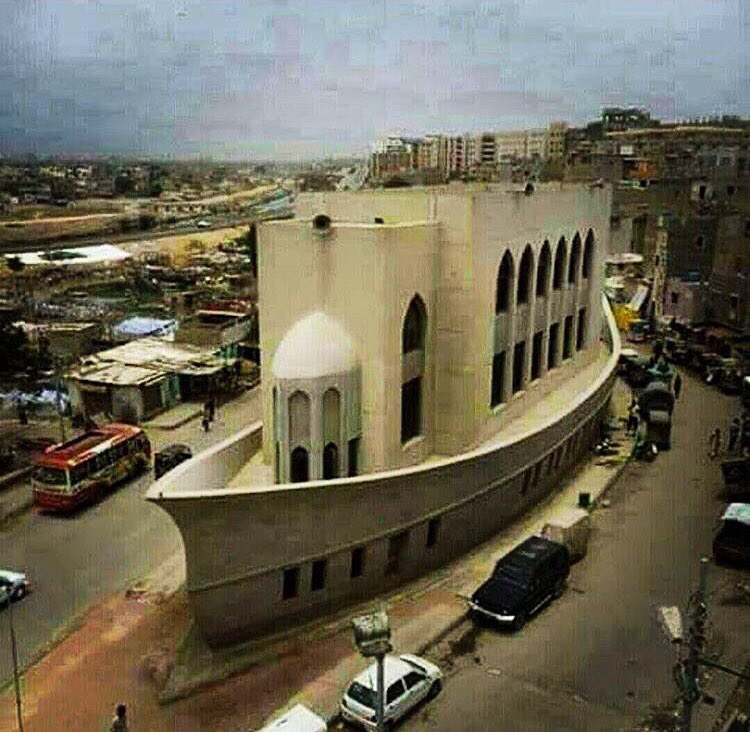SINDH (Karachi, Greater Karachi) Dec 9-16, 2021
Sindh Province (Mehran locally) name “Sindh” is derived from the Indus River that passes almost through the middle of the entire province. Boundaries: Balochistan – west, Punjab – north, Indian states of Gujarat and Rajasthan – east, and Arabian Sea – south. The capital is Karachi. Most are Muslim, with sizable Hindu, Ahmadiyya, Christian, Parsi and Sikh minorities.
Sindh’s first known village settlements date as far back as 7000 BCE. The culture blossomed over several millennia and gave rise to the Indus Valley Civilization around 3000 BCE with well-planned grid cities and sewer systems.
KARACHI (pop 17 million)
The largest city in Pakistan, Pakistan’s former capital, an industrial port city, capital of the Pakistani province of Sindh and the twelfth largest city in the world.. Ranked as a beta-global city, the city is Pakistan’s premier industrial and financial centre, with an estimated GDP of $164 billion (PPP) as of 2019. Karachi is Pakistan’s most cosmopolitan city, linguistically, ethnically, and religiously diverse, as well as one of Pakistan’s most secular and socially liberal cities. With its location on the Arabian Sea, Karachi serves as a transport hub, and is home to Pakistan’s two largest seaports, the Port of Karachi and Port Bin Qasim, as well as Pakistan’s busiest airport, Jinnah International Airport (KHI).
History. The city was founded in 1729 and drastically increased in importance with the British East India Company in the mid 19th century who transformed the city into a major seaport, and connected it with their extensive railway network. In 1949, the population was 400,000 when hundreds of thousands of Muslim refugees from India arrived. The city experienced rapid economic growth following independence, attracting migrants from throughout Pakistan and South Asia. The 2017 population was 16,051,521. Karachi is one of the world’s fastest growing cities, and has communities representing almost every ethnic group in Pakistan. Karachi is home to more than two million Bangladeshi immigrants, a million Afghan refugees, and up to 400,000 Rohingyas from Myanmar.
Today. Karachi is now Pakistan’s premier industrial and financial centre. Karachi collects more than a third of Pakistan’s tax revenue, has 30% of Pakistani industrial output and its ports handle 95% of Pakistan’s foreign trade. Approximately 90% of the multinational corporations operating in Pakistan are headquartered in Karachi. Karachi is considered to be Pakistan’s fashion capital.
Known as the “City of Lights” in the 1960s and 1970s for its vibrant nightlife, it developed high rates of violent crime, but went from the world’s 6th most dangerous city for crime in 2014, to 105th by early 2021.
Observations about Karachi
1. Karachi is a sprawling big city with little interesting architecture. When you get into west Karachi, it is intensely busy with narrow streets littered with speed bumps and enormous crowds of people.
2. Street food. I will miss the street food in Karachi and especially the collection of food stalls centered on a corner 2 minutes from my hotel. For breakfast, I eat at the paratha place and marvel at the guy on the one-meter-wide griddle. Paratha is a bread, rolled out very thin, stretched then rolled into a cone of dough. This sits and then is rolled out and slapped on the griddle which is constantly ladled with half cups of oil. He has a magical way of moving the cooking paratha around the grill while cooking fried eggs over easy and omelets. Paratha is much like a croissant and very delicious. Three servers are kept hopping with the 8 tables outside. Two of the servers are brothers, possibly 16 and 10 years old who appear to not go to school. A chai guy does only chai. I always have an omelet rolled in a paratha. Cost 85 PR including chai (about .45E).
For lunch and dinner, I eat either at the “burger” street wagon or at the biryani restaurant. Burgers are egg patties served on “hot dog” rolls with two types of sauce, tomato, cucumber, onion, and cabbage slaw doused in mayo and ketchup. Sauces are served on the side. Biryani is delicious flavoured rice usually served with chicken. I sometimes have haleem with naan alone or served with the biryani. There are also 5 other kinds of vegetable “stews” that can be served. They also make chapattis here or can get naan from a neighbor.
A guy makes French fries down the street. They are doused in spices and covered in ketchup and a variety of sauces, and then more spice. They are quite tasty and not piquant. 50 PR
Down the street is a “milk” place that serves milk or lassis in plastic bags. This may have been the source of my diarrhea as I assume it is not pasteurized. Also on the street is a tiny shop that has everything – UHT milk, detergent, pop, water. Some of these small stores also have a wide choice of drugs at cheap prices. No prescription is necessary.
I became a frequent customer and especially for breakfast had to say nothing and just sat down waiting for my food.
Often you get a small plate of veggies – onion, cucumber, cabbage slaw, carrot, and a hotter green sauce.
It is very cheap – burgers 50 PR, breakfast 85 PR, biryani with chicken and some haleem 200 BR, so it was easy to get a very filling, tasty meal for basically nothing.
3. People. Obviously mostly Muslim, the dress difference between the Muslims and Hindus is striking – from black hajibs to brightly coloured saris and exposed hair.
Older men dye their hair black or colour it with henna producing a garish orange colour.
The street coffee shops are full of young guys sitting around and chatting.
There is the whole range from the homeless to the foreign-educated living in small walled-off mansions – a much more unequal society than in western countries. The homeless are a desolate lot, barefoot, ragged clothes, laying anywhere, in a trance, and appear mentally ill. The saddest are small children on the street, absolutely filthy and often rooting through garbage tips. Most beggars are teenage boys or women, sometimes with small children. Many children appear to not go to school and are working. At the car rental place was an attractive kid whose goal was to play cricket and work cleaning cars.
At breakfast on my last day, an elderly man sat beside me. He was almost immobile with Parkinson’s disease
I have never figured out how to deal with beggars. I never give anything but that may not be right. Just like you should never feed any animal (especially if wild), a good travel rule is to never give children money as that encourages them to continue begging. But then everyone would need to follow the rule.
Pakistan had few or no touts. Nobody is trying to sell you anything or take a taxi. But Karachi has few tourists. The only ones I have seen are at the Mohetta Palace Museum.
Pan. Known as khat or betel nut, this is very common. It comes as a black liquid that is spread on leaves. It produces a lot of salivae that results in the frequent spitting of large amounts of red juice. It also stains their teeth red. It is mildly stimulating and obviously addicting.
4. Animals. Donkeys are common beasts of burden – pulling carts of produce, rebar, or once an enormous load of bamboo poles used as scaffolding. They appear well-looked after. There are herds of cattle (seen only once) or several goats on small barren areas between the road and a wall feeding out of plastic bins (one area had a least 15 small herds). Cats and dogs are rare.
5. Vehicles and transportation Get around in the cities with tuk-tuks. Riding around Karachi in a rick-shaw is not very healthy. One has the right-of-way when you are ahead of the other car. Beeping horns are not nearly as common as in Cairo. The buses would be difficult to navigate. There is no metro or trams in Karachi. I will have to start using Uber.
To get around the country, trains are not used much and buses are the only way to go. I rented a car which gives me the freedom to go anywhere and see every NM site possible. Most are small cars, small motorcycles, rickshaws, and trucks and buses that belch exhaust.
Some buses and most large trucks on the highway are lavishly decorated and painted all over.
6. Car rental. It is not possible to rent a car without a driver (at least that I have found). Booking online seemed impossible. Avis and Hertz were impossible to deal with and after 5 days of frustration, I finally phoned a local Karachi company, ZJ Car Rentals, and had a car in 10 minutes. The cost was 7000 PR/day + 2000/day for the driver (35E + 10E), not so cheap but with unlimited mileage. The car was a lovely 2021 Toyota Yaris with leather seats and more poser than what I have been used to renting.
Having a driver meant no excess insurance as the driver was responsible for any accidents (often costing about 10E/day alone). I didn’t have to worry about speeding tickets or parking tickets. It was not permitted for me to drive at all. All fuel costs were mine (gas 1.41 or 1.38 PR/liter (.70E) as were all road tolls (average 30-50 PR every 50 or so kms (.15-.25E).
The original contract was for 10 days with no refund for early return. I then reduced it to 8 days with the opportunity to extend. At the time of the rental, they added 8000 PR for oil charges. I objected and this was waived when I returned to the 10-day rental period.
2000 PR/day (10E) covered his food and accommodation which I was responsible for. It was his responsibility to find a place to sleep. The car rental covered his salary. If I paid for his meals and shared a room, I did not have to pay him anything. But if he decided to sleep in the car, as food is so cheap, he would lose out.
Having a driver is lovely. I can work on my computer, write this blog post, read, sleep or simply relax. No worries about anything. I realized in my first few hours that this was much better than I anticipated. Sadiq is 37, married with 4 young children, and speaks very little English. But I have Google Translate and we can communicate. He is very helpful in getting information.
5. Phones. Getting a SIM card for a foreigner is difficult and impossible at the small stores distributed all over. I had to go to the Jazz headquarters to obtain it but this was not the real headquarters and it was supposed to be activated in 15 minutes but wasn’t. I then visited two more “franchise store” where it supposedly took 6 hours to activate but wasn’t. I finally returned to Jazz Experience (the real headquarters) and had to buy another new SIM card. I still couldn’t activate it so returned the next day and found out I had to restart my phone to activate!! I would suggest waiting at the headquarters store until activation occurs as it is way down by the water in Clifton.
Day 1
I flew from Jeddah, Saudi Arabia on Dec 9 direct to Karachi arriving at 08:20. I couldn’t access money from the ATM at the airport using either debit card. I took a taxi to my hotel, Motel525. I have the biggest room, with a large unused space, a balcony and a gorgeous black tile bathroom. There are 4 young guys running and working in the place. Ismail helped me obtain a Jazz SIM card only available at their headquarters branch, a long drive away (it is not possible for a foreigner to simply buy a SIM card).
I have already become addicted to the street food. I had “burgers” for lunch – a fried egg patty, 2 types of sauce, tomato, cucumber, slaw on a hot dog bun served with more sauce, and ketchup. Delicious for 25 cents. Dinner was biryani. All is nicely medium picante.
Day 2
I spent all day at the hotel. It was Friday and everything was closed until 2 pm (museums don’t open at all). I worked on my book, read the Economist, entered all the Nomad Mania waypoints for all of Pakistan, downloaded most of the Google Offline Maps for the south, and caught up on my sleep.
For breakfast, I had paratha (oily coiled pancake) with an omelet, for lunch haleem with naan and chapatti, and for dinner biryani with chicken. Delicious.
Day 3
This was my first day out and about in Karachi. I exchanged money at a very favourable rate (much better than the money changers at the airport). The Jazz SIM card had been activated, so visited a nearby outlet but it took 6 hours to activate and then still didn’t.
For the rest of the day, I caught tuk-tuks and walked between several NM sites in Central Karachi. The tuk-tuk rides were amusing. I used Google Maps holding my phone beside the driver to navigate as I couldn’t tell them the destination. It was the first time any of them had ever navigated with GM and I think all were converted. They couldn’t believe that you followed the bright blue line.
The first ride from the Jazz office to the Christian Cross was 5.6 km and cost 500 PR (2.50).
Gora Qabaristan Cross (Christian Cross). At the entrance to a large Christian cemetery, this was built between 2014-18. It is 140 feet high with wings 40’ wide and a footing 20’ down. It’s white limestone with a base of white marble with 4 flying buttresses. Part of the inscription reads “Awaiting the Coming of Christ”. They will have a long time to wait.
All the tombstones are in English with names like Reginald Benjamin and Ernest Edgar Khan.
The construction was paid for by a Christian businessman, Parvez Henry Gill.
The Gora Cemetery (literally White (man’s) graveyard) is Karachi’s only operational Christian cemetery. Opened in 1843 on 20 acres, in 2016 it had 300,000 bodies registered to be buried here but space for only 3,000 graves, which means each grave has been used one hundred times over its history. In May 2002, the mutilated body of American journalist Daniel Pearl was found in the graveyard. No one knows how it was dumped there. The wall separating the Protestant and Catholic parts was removed.
The 2.5 km tuk-tuk ride was in a shiny new tuk-tuk with a new driver who didn’t know how much to charge me.
Karachi Cantonment Station. The main Karachi train station, there’s a new ugly modern building (the one that is used) and a yellow rough-cut limestone building built in 1865. It was restored in 2015 when 4 ½ inches of marble, concrete, and plaster were removed to restore the original stone.
Frere Hall*. Built in 1862, this looks like a large Christian cathedral but isn’t. It was built by the English as a public meeting space. Today it is an upscale gallery. The main artist was Aisha Khalid with very nice pieces – swords or animals often in guilt in elaborate repeating geometric backgrounds. The other art was Danish tapestries created using stick pins (often gold but other colours were used) pushed through a quilted fabric producing a clear image on one side and 3 centimeters of pins sticking out on the other – very unusual and very good.
Quaid-e-Azam House. The yellow limestone “mansion” was built in the late 19th-century, had a few owners including the British Indian Army, and then was purchased by Quaid in 1943. He was the first Governor-General of Pakistan and the “founder of the nation”. The former home of Jinnah, who lived there from 1944 until his death in 1948, he never actually lived in it as he was in the Governor General’s mansion but visited. His sister, Fatima Jinnah lived there until 1964. The building was later acquired in 1985 by the Pakistani government and conserved as a museum.
Outside are helper’s quarters, a kitchen and an open garage with a 1950s Cadillac and a Mercedes. Inside are typical living quarters with bedrooms upstairs. The furniture and finishing is unremarkable. The highlights are the large verandas and balconies surrounding the south side and the African arches. Free
I walked to the next 6 places.
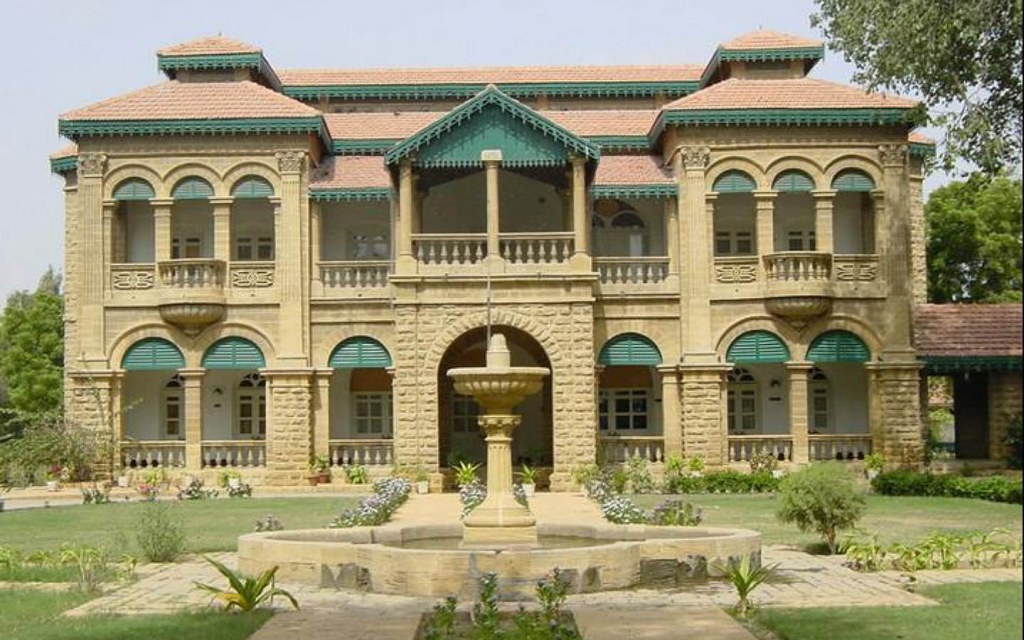
Zainab Market. A busy street is lined on both sides with larger shops, almost exclusively clothes, but some luggage on one side.
National Museum of Pakistan. Two floors of galleries with some interesting pieces but little that is spectacular. Gives a reasonable history from
Habib Bank Plaza. In the NM Modern Architecture Buildings series, it is one of the few skyscrapers in Karachi. I counted 20 floors. It is round with odd geometric concrete rectangles surrounding narrow windows.
TDF MagnifiScience Museum. This new museum has 3 floors of science fun. I actually enjoyed it. The Maze of Mirrors was quite interesting. 800 PR
State Bank Museum and Archives. Previously the Imperial Bank of India is a Greco Roman building in Jodhpuri Red Sandstone constructed in the 1920s by the British government and converted into a museum in 2006. In the coin’s gallery are minting and coins and a currency gallery, none of which I find very interesting. The only reason to come here is to see the building. 200 PR

Wazir Mansion (Quaid-i-Azam Birthplace Museum). In the NM House Museums series, is a former family home in the Kharadar district, the birthplace of the country’s founder, Muhammad Ali Jinnah. It was built during 1860-1870 with stone masonry. Jinnah was born in 1876 and spent 16 years of his childhood and youth here. Inaugurated as a museum in 1953, it was renovated in 2010 as a three-story building with a library and museum galleries.
It is small for a “mansion” and occupies a corner of two very busy narrow streets.
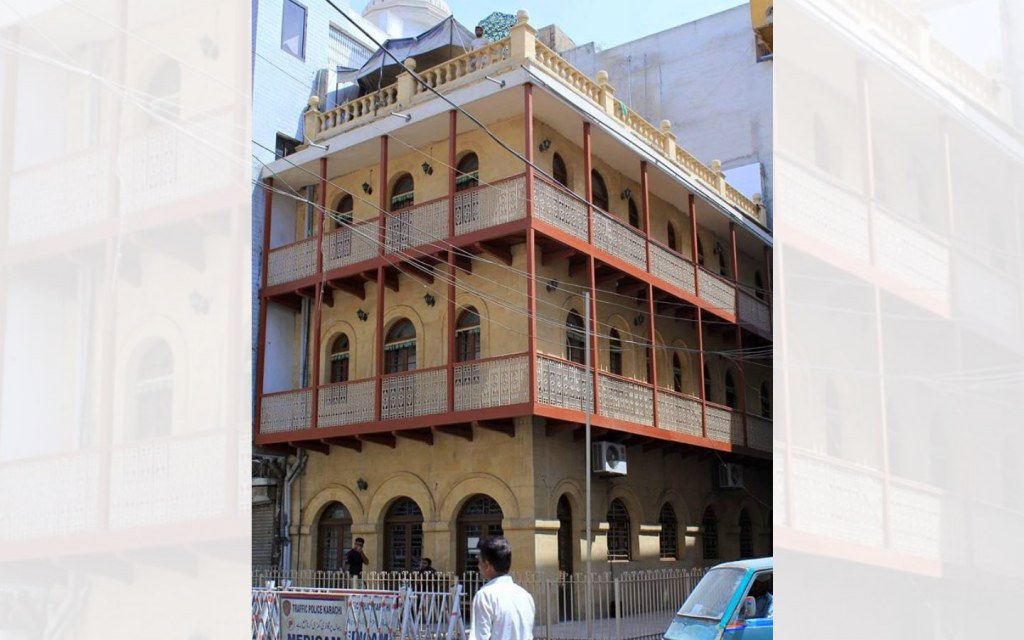
New Memon Mosque. A large white ceramic plaza fronts 13 large arches that open into the prayer room It has 3 unadorned domes and about 40 columns.
For my last “site” of the day, it was a 5.6km tuk-tuk ride. The driver took a very circuitous route through a lot of old Karachi, very narrow streets, many speed bumps, intense traffic. He waited outside the Boat Shaped Mosque and then drove me the long 7.8 km to my hotel. He only asked for 1000 PR (5 euros) and when I gave him 1,200, he was immensely surprised and grateful.
Boat Shaped Mosque. This small new mosque of grey stone is on the outskirts towards the northwest. It is in the shape of a boat, has a very low coffered ceiling, and a nice wood ‘cabinet’ for a mihrab.
On my second day sightseeing in Karachi, I saw everything to the north of the hotel. All involved long drives. I ended up using the same tuk-tuk driver for the last four.
St. Patrick’s Cathedral. This Roman Catholic cathedral was built in 1878 of yellow rough limestone, like all the other colonial buildings in Karachi. It is a 3-nave church with cross-rib vaults. Plain inside, it has nice bas-relief Ways of the Cross and a simple cross on the altar. Mass was occurring on a Sunday morning and all pews were full with Covid distancing. The church is fronted by a large marble monument built in 1931.

Lucky One Mall. This is a modern 4-story mall centered around a large open area. It seems high priced for most Karachi citizens, including the overpriced food court restaurants. There is a Covid vaccination place in the parking garage but it was closed (I would like to get a booster).
PIA Planetarium. This is a disappointing place with an old airliner and dated exhibits in the planetarium. 100 PR
Pakistan Maritime Museum. This open-air facility has two lakes with a submarine (20 PR), a minisub, a minesweeper, an airplane (20 PR), and several gun placements. Most saw action in the 1971 Indo-Pac War. There is also a museum. 60 PR
Pakistan Air Force Museum. In a nice open-air space with manicured gardens and grass, with the usual fighter jets, helicopters, and guns. These aviation museums are not very interesting. 60 PR
Day 5
I was up in the middle of the night with severe diarrhea. I have been rather careless. The most likely exposures were a lassi probably made with unpasteurized milk and a freshly squeezed orange juice cooled for 30 seconds with a large block of ice. I also brush my teeth with tap water and have once drunk water at a restaurant. The next morning I went down to the local shops, bought a large bottle of Pepsi (a good rehydration drink), more toilet paper and 15 doses of metronidazole (the best for parasites), and 10 tablets of Ciprofloxacin 500mg and took one Cipro. I didn’t eat all day, slept for over 20 hours and had no diarrhea since. From past experience, I think it is best to treat early.
I decided to stay in Karachi till Dec 16 (cheap, good hotel, good street food) as I also need a rest after 5 months of hard travel with no day off. I also have to have time to ensure that I have an activated SIM card and arrange a car rental.
Day 6
My day started trying to deal with Jazz and their SIM card. It is impossible to find their headquarters. My first was another franchise (my best guess at the HQ location) but the agent was not able to activate the card. I eventually found the HQ and was surprised to learn that it was not the same HQ that I had bought my original SIM (and may explain why it was impossible to activate). It turned out that I would have to buy an entirely new SIM (only €7.30) and reapply. I was reassured that I would have an active phone in 4 hours.
I then proceeded to see all my remaining Nomad Mania sites in Karachi. I also was very lucky in finding the best tuk-tuk driver – spoke reasonable English, could read Google Maps (a first), and negotiated traffic like a whiz. He was also very nice. Only 21, he had driven around Karachi for 6 years and loved his job. We went to the following sites, we had lunch and he returned me to my hotel.
Two Swords (Do Talwar). Two monuments in Karachi are Teen Talwar and Do Talwar (three and two swords). Jutting out from the two main roundabouts on main Clifton Road, the swords are made of white marble. Erected in 1973 in an upscale (posh) locality, it is now congested. Swords were the electoral symbol of Bhutto’s party and they symbolized the emergence of the Bhutto government. ‘Unity, Faith, Discipline’, were inscribed on each.
Both the monuments were erected on asphalt roundabouts with grass, flowers, and palm trees. By the 1990s, Clifton Road had transformed. It became extremely congested; trees were uprooted for apartment blocks, shopping centres, and advertising. Both had smog and dust on them. The grass was brown and the palm trees are gone. Posters and graffiti-covered the swords. Traffic increased, the size of both reduced, and traffic signals mounted. Religious inscriptions appeared and then sectarian graffiti of various extremist groups. They got a complete make-over.
It’s a favourite rallying point of the city’s liberal civil society groups protesting against various human rights violations.
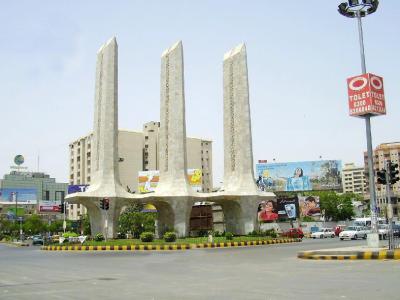
Zamzama Park. Urban Legend. A 26-acre park and posh locality located in Clifton Town. It has jogging tracks, walking paths, rollerblading enclosure, refreshment stand, playground, and Bonzai center. It is mostly large areas of manicured grass, small trees, and a large wall surrounding it. It is a highly developed commercial area with residential accommodation as well. Famous branded shops are in this area.
Clifton Beach is located on the Arabian Sea. It stretches from Karachi to Ormara (Balochistan). The beach is very popular in Pakistan. It is open 24/7 for the general public. Clifton Beach is purported to give the best value in leisure and recreational opportunities for fun seekers and beach lovers.
In recent times, the area surrounding the beach has seen massive commercial activity as it is located in one of the most sought-after localities in Karachi. The beach is now home to multiple local leisure activities including camel rides, buggy rides, horse rides, plastic plane flying among others. The Seaview Apartments across from the beach is a gated residential area that is rated among the top properties in the city. Other apartments and villas which can be seen along the Clifton beach coasts are becoming popular as well.
Previously, Clifton Beach had only had a few small shops known as “Corniche Points”, where visitors could buy things like mineral water, samosas, chai, and other foodstuffs.
Now, Clifton Beach offers a variety of restaurants, including a McDonald’s, and is bustling with and a multitude of vendors that entertain visitors. Do Darya restaurant is located further away from the main beach area but is still one of the hottest dining spots in Karachi. Extensive further revitalization is being planned.
Clifton Beach is one of Karachi’s major tourist attractions so the most notable celebrations are done here by the citizens. A major event of the year is the New Year’s celebration on the eve of 31 December each year. Also, the Pakistan Air Force now holds regular shows on Clifton Beach on important national events. These air shows consist of planes from the PAF showing acrobatics and flypasts to the audiences.
It is many kilometers long. One must walk at least 200 m from the parking across flat sand to reach the shallow water. As above, there are dressed-up camels and horses to ride. Guys in small dune buggies hassle you to drive to the water. The beach was busy but no one was in the water. My driver said that it is very polluted and you get skin rashes. Everyone was simply walking and enjoying the nice day.
Mohatta Palace. Built in 1927 by an Indian entrepreneur, it is built of dressed yellow limestone and pink Jodhpur stone in Moghul new architecture. I tas lived in it until 1947 when the Pakistan government bought it. It was then abandoned and then renovated in 1999. The ceilings are the only thing visible as the walls have walls up to show art. They are painted or have elaborate stucco decorations. The floors are lovely white marble. the grounds are manicured grass and trees next to a high wall.
It now holds a museum with rotating exhibits on the first floor. The second floor could not be accessed. There were two rooms of Gez embroidery from the Megwah people who live next to the Indian border. All was on clothing, beautiful, and used small round mirrors extensively. Another room had rallies of Sindh quilts again stunning. A small exhibit had stonework from Gandhara. 30 PR
Masjid-e-Tooba. This spectacular mosque built in 1996-99 is one large dome with no columns – 212 feet in diameter, 51.98 feet high with a cone minaret that tapers to a point 126 feet high. The ceiling is small mirrors enclosed in pentagons. The 2.3 m high side walls are millions of tiny marble squares and triangles. It is a truly spectacular mosque.
The prayer hall itself holds 5,000, with the surrounding plaza 8,000 and with the lawns 30,000 worshippers.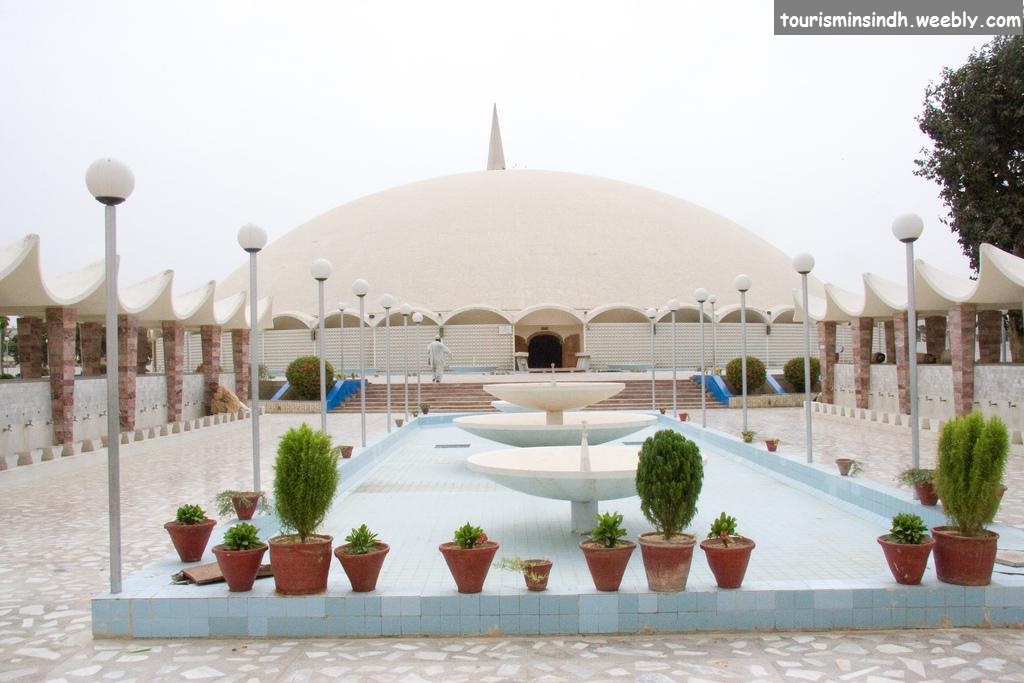

Day 7
This was my complete day off to putter around doing things I enjoy – writing my book on Asperger’s, reading the Economist, the Atlantic, and Time magazines. I needed a day to help recuperate from my recent bout of traveler’s disease and 5 months of full-on travel.
As my SIM card was still not activated, I returned to Jazz Experience and found I only needed to restart the phone.
My quest to find a rental car continued all day. I talked to Rental Cars Pakistan several times to eventually determine they were in Islamabad. Hertz has been impossible to communicate with or deal with despite going to their office in the swank Movenpick Hotel. Finally, in the late afternoon, I phoned ZJ Car Rentals in Karachi and had a car in 10 minutes. We communicated effectively on Whatsapp. A 2021 Toyota Corolla for 10 days with a mandatory driver costs 70,000 PR (350 €) but I also need to pay for the driver’s food and accommodation. Hopefully, he speaks English and does not object to seeing the hundreds of NM sites I want to visit. But it should be very relaxing to sit back, read and relax and not worry about accidents and buying excess insurance.
Although my hotel (Motel525) was great in many ways, there are always issues, mainly the 4 young guys who work and live in the hotel. None speak English. They spend all evening on their phones watching crap, use all the bandwidth and make the wifi unusable then. They never wash their dishes and the counter in the kitchen is covered with plates of half-eaten food. One fellow wanted me to help him emigrate to Canada and he couldn’t understand why I would be unable to help him. Besides his lack of English, he had no education and no skills.
Also, the day before I left, an Indian family moved in with small children. I have never seen so much old, decrepit stuff in my life as they brought their entire household belongings with them.
Day 8
I checked out at 08:30 and took a tuk-tuk 8 km to ZJ to hash out the details of the car rental.
